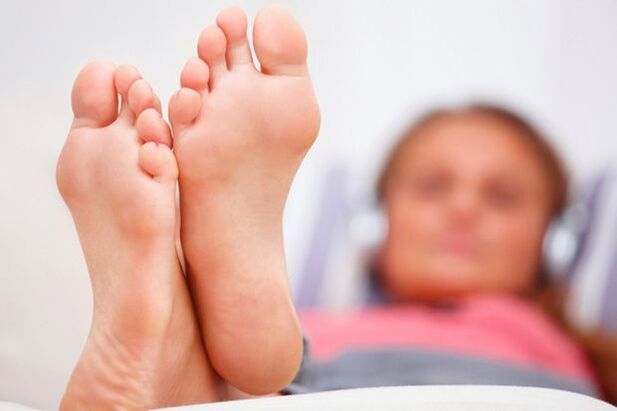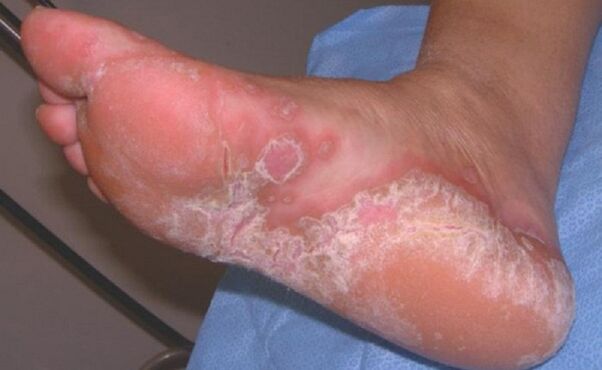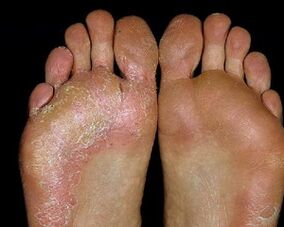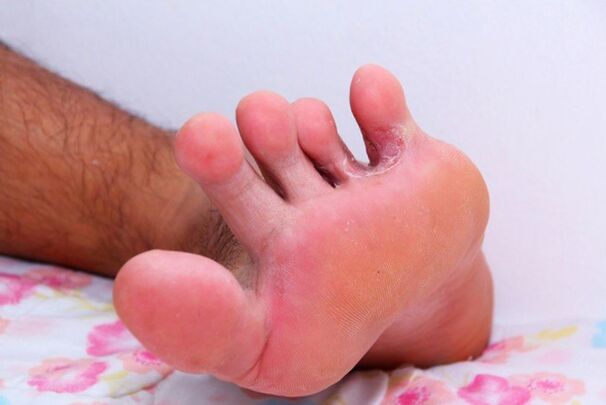Flexibility of the feet (mycosis) is a fairly common disease, a sign of damage to the skin.
Infection occurs during healthy skin contact with spore carriers, as well as through household passages: through shoes, shared bathrooms and contaminated items. Fungal infections easily penetrate the interdigital fold (under favorable conditions), where it begins its path and population growth across the surface of the foot.

What is a Fungus?
Foot mycosis is the most common type of dermatomycosis, characterized by chronic relapse. It includes both damage to the skin and nail layers. The top layer of skin, which is constantly peeling, contains a mass of fungi, as well as their spores.
Fungus is an infectious disease that is spread from person to person through household items. The interdigital folds are the first to be affected, as a result of which itching appears. After that, the infection covers the entire foot area. The disease develops rapidly, and is characterized by the presence of itching, burning, pain, dry skin, peeling and even diaper rash.
Because of the appearance
The main causes of this disease are microorganisms of the genus Trichophyton, as well as mold. Infection with them occurs under the following conditions:
- wearing tight shoes (when the foot is squeezed, cracks and bed sores form, where infection easily develops);
- excessive sweating on the feet (this is an excellent environment for the development of fungal populations);
- with high humidity in the room (shower, bathroom) - good conditions for all types of fungi;
- frequent visits to saunas, swimming pools (risk of contact with carriers of the infection increases);
- the presence of a sick person in the family (you can be infected through household items: slippers, socks and a shared bath).
There are also some diseases in which a person is susceptible to fungal infections:
- immune deficiency (a weakened immune system is more susceptible to infectious and bacterial diseases);
- taking hormone medications (violating hormone levels);
- flat feet (with this disease it is difficult to choose shoes with the right rise, often the feet are squeezed);
- varicose veins (poor circulation causes dry skin);
- atherosclerosis;
- diabetes mellitus (there is an increase in capillary permeability, changes in their barrier function).
symptoms

The main symptoms of foot mycosis are:
- burning and itching between the lower toes (in the initial form) and the entire surface of the foot (at a later stage);
- painful sensations (with varying intensity: the pain may grow, then disappear completely for a short time);
- skin redness (from pink to purple);
- excessive dryness and flaking (separation of scales and crust from plaque);
- cracks on the skin of the feet (which are not lost with conventional moisturizers);
- changes in the color and structure of the nail (it becomes thick and flaky);
- the presence of an unpleasant foot odor (if it has not been observed before).
Important!
With fungal infections, regular hygiene procedures (foot washing, pumice stone and steaming) do not give any results, the symptoms do not go away!
Why does fungus need to be treated?

The success of therapy depends on the accuracy of the diagnosis and the identification of the exact type of agent that causes foot mycosis. Regardless of the form and stage of the fungal infection, an integrated approach is used in treatment.
Without an efficient approach to treatment, the fungus will not go anywhere, this is not a disease that goes away on its own.
After all, the waste products of parasitic fungi will spread to the surrounding tissues and enter the bloodstream, poisoning them, and these are allergens to the human body (eczema may develop).
In addition, a person infected with the fungus is a source of infection and danger to others. After all, infection occurs through household items and through contact with the skin of an infection carrier.
Fungal forms
In total, 6 forms of foot fungal lesions are distinguished:
- Deleted form. This is an early form, it differs in the following manifestations: slight peeling in the interdigital folds and small superficial cracks, which do not cause concern.
- Squamous shape. The presence of small scales between the toes and on the surface of the soles of the feet. No signs of inflammation other than mild itching.
- Hyperkeratotic form. Appearance of blue-red plaques (papules), located in the arch of the foot. Dry skin, mild pain and itching were observed.
- Intertriginous forms. It looks similar to a diaper rash. The skin in the interdigital folds becomes bright red, swelling and weeping cracks appear, and even erosion may occur. Pain, burning and itching complete the picture.
- Dyshidrotic form. The appearance of bubbles is noted, which is covered from above with a solid lid. They are localized in the arch of the foot and are characterized by severe itching.
- Acute form. The skin of the feet is covered with vesicles and blisters with purulent-serous contents, the opening of which leads to various erosions and deep cracks. Body temperature increased significantly, the skin of the feet was bright red, there was severe pain, difficulty walking, headache and general weakness. Inguinal lymphadenitis develops.
Virus diagnostics
Diagnosis of the disease is carried out by a dermatologist or mycologist (it depends on the zone and degree of fungal infection), and is based on the detection of the fungus when examining the skin scales under a microscope.
The skin is taken from the affected foot area by scraping, after which it is treated with a special reagent. In the process of examining it under a microscope, the specialist determines the type of pathogen, or grows the fungus in a nutrient medium (it is easier to determine its type with increasing population).
Methods of treatment

The basic rule in the treatment of foot mycoses is an integrated approach, which includes not only the use of medications, the use of alternative treatment methods, but also careful care of the affected skin.
Before starting drug therapy, you should consult a doctor who will identify the pathogen using laboratory tests. Foot mycosis should be treated under the close supervision of a physician, or in a hospital setting. Therapy is carried out in 2 stages: preparatory and basic.
The first includes the removal of inflammation, as well as the removal of the stratum corneum using early steaming of the foot in a solution of potassium permanganate and boric acid.
The second stage involves drug treatment.
Treatment with drugs (ointments, creams, tablets, other drugs)
After removing the upper keratin cells, a special cream with antibiotics and corticosteroid hormones is applied to the entire affected surface. After elimination of inflammation, the foot bath is canceled. Further treatment consists of deep removal of the horny layer using salicylic petroleum jelly.
It is applied in a thin layer to the lesion site until the corneal particles are completely removed. Also effective are therapies to strengthen immunity: take immunomodulators and vitamin complexes, because the stronger the immune system, the faster the disease passes.
Important!
It is forbidden to use ointments! They can cause weeping erosion.
Treatment with folk remedies for this disease can only be an adjunct therapy, and not the main method of treatment.
Restoration of the people
Treatment should be systematic and include not only drugs, but also folk remedies:
- Apple cider vinegar is considered the best recipe like that, because fungi do not like acidic environments. The method of application is quite simple - apply a vinegar solution to the affected area (concentration is selected individually), wear socks and sleep.
- Laundry soap and baking soda are another effective method. You need to grate 3 tablespoons of soap and add the same amount of baking soda. Pour this mixture with hot water (at least 5 liters), lower your feet there for 15-20 minutes. After the procedure, clean the feet with a nail file or pumice stone.
- Also, significant results are shown by glycerin with vodka. It is necessary to add a bottle of glycerin purchased with alcohol to full, shake and moisten the exfoliation with this composition daily (before bedtime).
- Coffee is effective in combating mycosis. You should brew strong coffee, dip your feet into the drink until it is cool. It is recommended to perform this procedure for at least a week.
- Celandine is also a good helper for fungal infections. You need to pour 1 liter of water into the kettle, put on the stove, boil and add 4 tbsp. l. herbs (boil for 5 minutes). In the resulting infusion, you need to toss your legs for 3 weeks every day.

How to cure fungus in children?
Treatment of mycosis in children occurs in several stages:
- steaming the feet (in a solution of soda and laundry soap, or with the addition of apple cider vinegar, you can also use chamomile soup - an excellent antiseptic);
- removal of keratinous particles (with pumice stone or a coarse cloth, rub the exfoliating surface until the top layer of the epidermis is exfoliated);
- treatment with 2% iodine of the affected area promotes healing and disinfects well (you can apply iodine mesh on infected skin);
- before bed, apply a cream based on miconazole and nystatin (it is safe for children and quite effective) and wear cotton socks (or special antibacterials).
Disease prevention
The preventative measures are relatively simple and include the following:
- Adherence to the rules of personal hygiene (especially when visiting public pools, baths and saunas). It is necessary to move with slippers, do not be barefoot on the floor and do not wear other people's shoes.
- When visiting, you should also take off your slippers and walk indoors with socks on.
- Wash your feet with antimicrobial soap and wipes daily before bed.
- Make sure you dry your feet after washing (especially between the toes).
- When keratin cells appear, they need to be treated with pumice stone and scissors or tweezers.
- You need to trim your nails on time, preventing them from delaminating.
- If there are cracks in the legs, you must use special gels and creams.
- Wearing tight shoes is not allowed, as it affects blood circulation.
- In case of cuts and scratches on the skin of the feet, it is necessary to treat it with a brilliant green.
- With increased foot sweat, it is necessary to use special sprays and gels (not sold in any pharmacy).
Conclusion
Foot mycosis is a dangerous disease that not only causes uncomfortable sensations and spoils the appearance of the skin and nails, but can also cause eczema, as well as decreased immunity. In order not to be infected with the fungus, it is necessary to adhere to basic hygiene standards.
Well, in case of infection - immediately seek advice from a specialist who will diagnose and prescribe effective treatment. Mycosis is easily defeated if treatment is started on time.
















